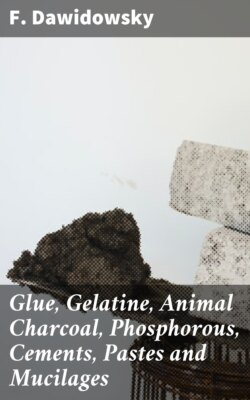Читать книгу Glue, Gelatine, Animal Charcoal, Phosphorous, Cements, Pastes and Mucilages - F. Dawidowsky - Страница 5
На сайте Литреса книга снята с продажи.
1. SOURCES OF GLUE.
ОглавлениеThe organisms of all animals, but more especially of the higher classes, contain tissues which are insoluble in cold, as well as in hot, water. However, by continued boiling they become dissolved, and yield on evaporation of the solution a glutinous, gelatinizing mass. By further drying this mass exhibits, according to the degree of purity of the material, a more or less transparent and brittle substance, which in its pure state is devoid of color as well as of smell; it swells up in cold water and dissolves by boiling in that liquid. This substance, i.e., the product of the conversion of the so-called glue or gelatine-yielding tissue, is what is known in the trade as glue.
Among the glue-yielding tissues, the following are the most important: Cellular tissue, the corium, tendons or sinews, the middle membrane of the vasa lymphatica and veins, the ossein or organic matter of bones, hartshorn, cartilage, the air bladders of many kinds of fishes, etc.
Neither glue nor gelatine exists ready formed in the animal organism, except under abnormal conditions as a phenomenon of disease, but they are the products of various transformations. The first of these transformations evidently takes place in drying the hide, since the result of boiling to glue a green hide prepared in the usual manner by liming, etc., but not previously dried, will be an entirely different product of less consistency than that obtained by drying the hide after liming and then boiling. A second transformation seems to take place in boiling the material, and a third in drying the jelly obtained, and this may explain the fact that the latter, which is not converted into actual glue, differs in its behavior from glue solution. The series of transformation does not end even with the actual glue, for it is a well-known fact that glue dissolved in water and boiled for some time does not gelatinize on cooling, but remains liquid. We have here to deal with organic combinations which are distinguished from the more solid organic compounds by passing more readily into decomposition. However, it is an established fact that glue is an organic combination presenting itself in different modifications. In the animal organism it occurs ready formed only under abnormal conditions as a phenomenon of disease, and hence it is only produced by first drying and then by continued boiling of the glue-yielding substance, and finally by evaporating and further drying the gelatinous mass obtained by boiling.
